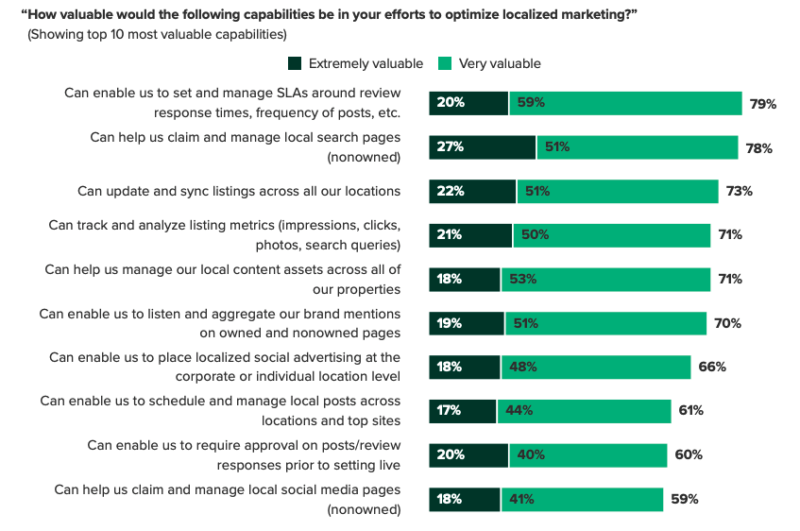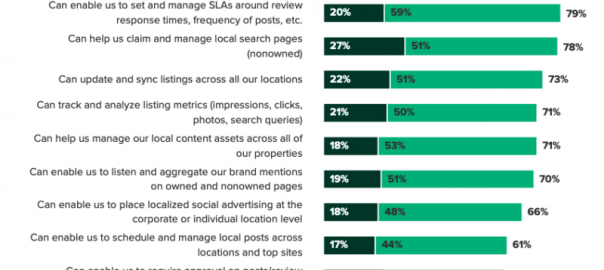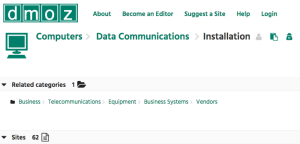But 77% of multi-location brands complain executing locally at scale is very challenging.
When people hear the phrase “local business” they tend to think of mom and pop stores. But national brands like Chipotle, Anytime Fitness, Home Depot, Macy’s and Walmart are also local businesses because they exist in specific communities.
Local laggards. Despite the fact that they make most of their money in stores, multi-location brands have typically been slow to focus on local-digital marketing tactics such as local SEO, GMB optimization, review management and localized social media marketing. Many have traditionally relied on national strategies despite evidence that consumers engage with these entities primarily at the local level.
A new survey (registration required) from Forrester, commissioned by SOCi, finds that 60% of multi-location marketers agree local ratings and reviews and social media have “a direct impact on their customers’ decisions to visit a store and make a purchase.” And 61% now say that improving local marketing effectiveness is a high priority “next year.”
But the gap between aspiration and implementation is significant. While extolling the benefits of a coherent localized marketing strategy, the study identifies a number of common operational barriers to effective tactical execution.
Operational barriers. The majority (61%) of Forrester’s respondents (154 multi-location brands) admit that local digital marketing remains for them “a largely untapped opportunity.” And 77% complain that executing a local-digital marketing strategy across all their stores is very challenging.
All of the marketers surveyed are doing some form of local-digital marketing, albeit incompletely or inadequately. The organizational challenges and pain points the study identifies include:
- Not enough resources to scale marketing programs locally across hundreds of stores and locations
- Siloed operations: a lack of internal cooperation and coordination among teams
- Lack of interaction between in-house marketers and external agencies that are managing different channels or campaigns
- Gaps in strategy: 31% reported no locally targeted paid social media strategy
- Use of distinct software solutions that aren’t integrated for a global or holistic view of performance
- Inability to respond quickly to customer engagement or complaints at the local store level
The survey also asked marketers to identify a multi-location marketing priorities wish list. Interestingly, vendor SLAs that enable tighter publishing schedules and review management response times was the top request, followed by claiming and managing local search pages (e.g., GMB, Yelp, Facebook).
Multi-location capabilities wish list

Another interesting set of findings revolves around the structure of local-digital marketing efforts. There are three general approaches:
- Centralized — this top down model, where everything is done at the corporate level, is being used by 32% of respondents. This often compromises the ability to respond to local questions or reviews in a timely way
- Decentralized — the least common approach, this is used by 23% of respondents. It delegates marketing strategy and execution to local stores or franchisees. And while it enables local responsiveness, it may generate inconsistency or a lack of alignment between local and brand initiatives
- Hybrid — used by 45% of respondents, this requires coordination between corporate teams and local managers or marketers at the regional or store level. This is the most common approach but requires tools for governance and managing the tensions between local and national control
About half of survey respondents rate their localized marketing efforts as “average or below average.” The report concludes with a set of recommendations for overcoming the operational and technology challenges discussed above.
Why we care. With the growth of COVID-driven online buying, you might be tempted to think that the role of stores and local marketing will be diminished over time. The opposite is true. Developments like “buy online pick up in store” are strategic hybrids that combine e-commerce with the immediacy of local stores.
Consumers have become more invested in their communities since COVID, not less; and near-me search continues to grow. It’s going to become even more important for national-local brands, chains and retailers to execute effectively against local searches and local-social engagement, which is increasing not declining.
Marketing Land – Internet Marketing News, Strategies & Tips
(50)







